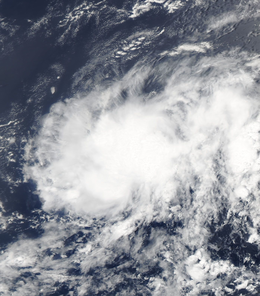Tropical Depression Ten (2005)
| Tropical Depression (SSHWS/NWS) | |

Tropical Depression Ten shortly after formation on August 13
|
|
| Formed | August 13, 2005 |
|---|---|
| Dissipated | August 14, 2005 |
| Highest winds |
1-minute sustained: 35 mph (55 km/h) |
| Lowest pressure | 1008 mbar (hPa); 29.77 inHg |
| Fatalities | None reported |
| Damage | None |
| Areas affected | None |
| Part of the 2005 Atlantic hurricane season | |
Tropical Depression Ten was a tropical depression of the record-breaking 2005 Atlantic hurricane season. It formed on August 13 from a tropical wave that emerged from the west coast of Africa on August 8. As a result of strong wind shear, the depression remained weak and did not strengthen beyond tropical depression status. It degenerated on August 14, although its remnants partially contributed to the formation of the tropical depression which eventually became Hurricane Katrina. Thus, it is generally referred to as "the precursor to Katrina". The cyclone had no effect on land, and did not directly result in any fatalities or damage.
On August 8, a tropical wave emerged from the west coast of Africa and entered the Atlantic Ocean. Tracking toward the west, the depression began to exhibit signs of convective organization on August 11. The system continued to develop, and it is estimated that Tropical Depression Ten formed at 1200 UTC on August 13. At the time, it was located about 1,600 miles (2,600 km) east of Barbados. Upon its designation, the depression consisted of a large area of thunderstorm activity, with curved banding features and expanding outflow. However, the environmental conditions were predicted to quickly become unfavorable. The depression moved erratically and slowly towards the west, and wind shear inhibited any significant intensification. Late on August 13, it was "beginning to look like Irene-junior as it undergoes southwesterly mid-level shear beneath the otherwise favorable upper-level outflow pattern". The wind shear was expected to relent within 48 hours, prompting some forecast models to suggest the depression would eventually attain hurricane status.
By early August 14, the shear had substantially disrupted the storm, leaving the low-level center of circulation exposed from the area of convection, which was also deteriorating. After meandering, the storm began to move westward. Forecasters expected it to resume a northwestward track as high pressure to the south of Bermuda was forecast to weaken and another high was predicted to form southwest of the Azores. By 1800 UTC on August 14, the strong shear had further weakened the storm, and it no longer met the criteria for a tropical cyclone. It degenerated into a remnant low, and the National Hurricane Center issued their final advisory on the cyclone. Moving westward, it occasionally produced bursts of convective activity, before dissipating on August 18.
...
Wikipedia
